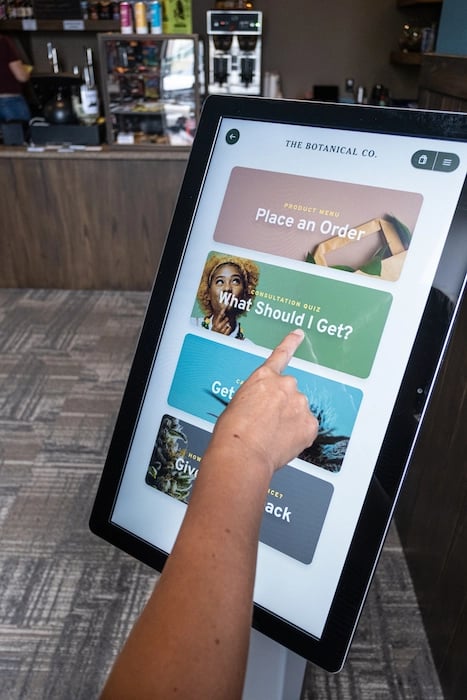The complete guide to cannabis digital signage
Learn everything you need to know about cannabis digital signage, including what it is, the benefits, and tips for choosing a signage provider.
What's the best way to share a dispensary menu with customers? We asked shoppers how they prefer to see cannabis product lists.
Cannabis isn’t like other industries, where shoppers can browse, touch, smell, and explore every item on the sales floor. Most retail stores don't need menus. You do.
Most cannabis retail stores use paper (printed menus), digital (TV menus), interactive (tablets), and/or verbal products menus.
But how do your shoppers actually want to see your product list?
We asked cannabis consumers how they prefer to see a dispensary’s product list.
Here’s what they said:
Let’s explore.
The overwhelming majority of respondents want digital forms of dispensary menus. This means that your shoppers prefer to see strategically-placed TVs on the wall showing your product list.
Or they want to be handed a tablet to sort and scroll through.
Why?
Consumers are used to glancing up at a screen on the wall. Whether it’s rotating through a full product catalog, static on a certain category (e.g. all edibles), or using graphics to highlight deals or new/hot/featured products, shopper behavior is influenced by what’s showing on a screen.
And it happens fast.
They glance up, see a featured edible, then see edibles are on sale, decision made! For consumers who don’t want a thorough review of your products, with details on each, TVs help them see and decide quickly.
Generally cannabis consumers have a starting point. For example, they know they want flower. With an interactive solution, they can see just your flower options, separated by price point, THC %, brand, or whatever other details are most important to them. Interactive tools easily and quickly narrow their search, and help them be confident in their purchase.

Many people are visual learners, meaning they need to see information in order to understand or process it. If a budtender starts talking about different products and their benefits or potency, none of it registers without having something to look at as well.
Relying on verbal menus will frustrate and confuse your visual customers. Especially since you can't hand them the actual product to look at while your'e talking about it.
Digital tool can aid the conversation, both letting them see the product, while also having more details right there.
Verbal or basic printed menus could work with experienced shoppers who know what they want, or who always get the same thing. But for newer consumers, or those who value the dispensary experience of exploring new products, they need more educational support.
Digital tools help them see the product, and all its details. Even the best budtenders may not have everything memorized. And customers care about potency, terpenes, price, size, onset time, purported effects. Using digital as a sales aid helps ensure shoppers get all the details they want — accurately — to help them make the best decision.
Analog means not digital, so in this case, that includes paper or printed menus, no menus at all, or sharing product details verbally only.
If your dispensary carries very few products, maybe 2-5 per category, it’s possible that you can be very successful with only analog-style menus. Verbally explaining two products is feasible. Especially with a more experienced clientele.
But this isn't the case for most cannabis dispensaries. Often stores have thousands of SKUs. It’s impossible to carry this many products and use only analog menus.
Why? Verbal won't work. Having no menus definitely won't work. And printing is a logistical nightmare to keep everything updated, including what’s in stock, and price changes.
The biggest challenge with analog; it's not automated. It’s not scalable. It’s a poor experience for both your customers, and your staff.
When asked about how they prefer your menus, most respondents selected more than one menu type. This means they want multiple avenues to get information.
Many people want a combination of digital (TV’s, tablets, etc.) and analog (print, verbal, etc.).
Think about a typical dispensary shopping experience:
Customer notices a TV in the waiting room promoting a new product.
Asks the budtender about it.
Budtender ask a few questions about customer needs/wants, consumption methods, etc.
They either agree that the product would be a good fit, or offer something else.
They use a tablet or point to a TV showing the other options that could work.
This back-and-forth continues, maybe drilling deeper into a few products.
Customer decides, pays, and leaves.
The whole process was smooth and conversational, but smart in-store digital technology supported the sales process and helped ensure you get the right product for your needs.
Cannabis dispensary customers need to know what products you carry, both for their shopping satisfaction, but also to achieve your inventory and sales goals.
The key is to give them a combination of ways to understand what cannabis products you carry, but remember that the majority prefer digital dispensary menu options.
The takeaway: Customers care about your in-store experience, and the technology involved, but have different preferences. To satisfy all types of shoppers, provide options in your dispensary — like digital menus + analog options.
Learn everything you need to know about cannabis digital signage, including what it is, the benefits, and tips for choosing a signage provider.
Learn the definition of dispensary digital signage, why cannabis retailers need it, and what to display on your screens.
What is a dispensary kiosk? And how do kiosks make your dispensary more profitable? We break it all down here.
Schedule a demo to see how Seed Technology can help you achieve your retail goals
LEARN MORE